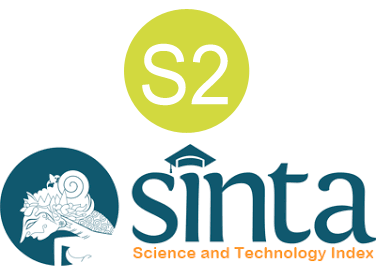Estetika Posmoderen: Idealisasi Seni Karawitan dalam Agama Hindu di Bali
DOI:
https://doi.org/10.37329/jpah.v9i1.3683Keywords:
Modern Aesthetics, Eddialization Karawitan Art, Balinese GamelanAbstract
Balinese musical art is essentially a cultural heritage passed down from generation to generation from the predecessors, and always adheres to existing traditions, relying on traditional patterns that develop in society. There is no traditional or religious ceremony in Bali without the involvement of musical arts. The diversity and complexity of Balinese gamelan playing has been the subject of study among researchers with various scientific approaches. This paper aims to discuss the art of Balinese gamelan music in the realm of postmodern aesthetic studies, one of the disciplines that is growing quite rapidly today. This research uses a descriptive method of analysis with data collection techniques such as observation, interviews, and literature studies as well as the author's experience as a musical performer. The results of this study show that in the last decade or 10 years there has been a fundamental change in the process of creating new works in Balinese karawitan. The process of creating new works, which has been based on a strong tradition, has now changed into contemporary (modern), postmodern or contemporary art. This phenomenon occurs due to the change in the mindset of artists who always want to keep up with the times. The forms or idioms of postmodern aesthetics found in the process of creating new works in Balinese musical art include Pastiche, Parody, Kitsch, Camp, and Schizophrenia. The emergence of postmodern aesthetic idioms in new Balinese musical works from artists at this time is to fulfill the need for beauty values as humans in general, also based on the desire to achieve intrinsic values contained in the art itself to achieve perfection as a human being.
References
Ardana, I. K. K., & Consentta, M. G. I. Della. (2022). Estetika Tri Mandala Dalam Komposisi Baru Pasupati: Strategi Pengembangan Wacana Keindahan dalam Karawitan. Resital: Jurnal Seni Pertunjukan, 23(1), 15–27.
Barker, C. (2000). Cultural studies: Teori dan praktik. Yogyakarta: Bentang.
Crowther, P. (2019). Geneses of Postmodern Art Technology As Iconology. New York: Routledge, Taylor & Francis Group.
Dibia, I. W., & Wahyudi, S. (2004). Pragina: Penari, Aktor, dan Pelaku Seni Pertunjukan Bali. Malang: Sava Media.
Gie, T. L. (2004). Filsafat Keindahan. Yogyakarta: Pusat Belajar Ilmu Berguna (PUBIB).
Hasanah, N. (2019). Schizophrenia As an Aesthetic Device of a Literary Work. ISLLAC : Journal of Intensive Studies on Language, Literature, Art, and Culture, 3(1), 49–56.
Isrow, Z. (2017). Defining Art and its Future. Journal of Arts and Humanities, 6(6), 84.
Moleong, L. J. (2021). Metode Penelitian Kualitatif (Edisi Revi). Bandung: PT. Remaja Rosdakarya.
Piliang, Y. A. (2012). Semiotika dan Hipersemiotika Kode Gaya dan Matinya Makna (Keempat; A. Adlin, ed.). Matahari.
Piliang, Y. A. (2016). Hipersemiotika Tafsir Culture Studies Atas Matinya Makna. Yogyakarta: Jalasutra.
Rianta, I. M., Santosa, H., & Sariada, I. K. (2019). Estetika Gerak Tari Rejang Sakral Lanang Di Desa Mayong, Seririt, Buleleng, Bali. Mudra Jurnal Seni Budaya, 34(3), 285–393.
Rai S. I Wayan. (2021). Penciptaan Karya Seni Berbasis Kearifan Lokal Papua. Jayapura: Kerjasama ISBI Tanah Papua dengan Penerbit Aseni.
Sari, A. P. (2024). Gamelan Bali Dalam Konstelasi Filosofis Dan Estetik. Sphatika: Jurnal Teologi, 15(1), 34-46.
Santosa, H., Saptono, & Sutirtha, I. W. (2022). I Nyoman Windha Sang Maestro Karawitan Bali (Abdul, ed.). Denpasar: Penerbit Adab.
Santoso, I. B., Sunarto, B., Santosa, S., & Mistortoify, Z. (2023). Ungkapan Estetika Karawitan Jawa pada Reproduksi Rekaman Gamelan Ageng Surakarta. Resital:Jurnal Seni Pertunjukan, 24(1), 10–21.
Saptono. (2004). Sajian Komposisi Karawitan Sebuah Kategori Contoh Dalam Wacana Estetika Postmodern. Denpasar: ISI Denpasar Press.
Sudirga, I. K. (2020). Komposisi Karawitan dalam Perspektif Estetika Posmodern. Journal of Music Science, Technology, and Industry, 3(2), 181–200.
Sumardjo, J. (2016). Filsafat Seni. Bandung: ITB Press.
Sutisna, R. H., Wiresna, A. G., & Sukmana, E. (2023). Gamelan Koromong dalam Konteks Ritual 14 Mulud pada Masyarakat Cikubang Sumedang Jawa Barat. Resital:Jurnal Seni Pertunjukan, 24(2), 176–190.
Titib, I. M. (2003). Teologi Dan Simbol-Simbol Dalam Agama Hindu. Surabaya: Paramita.
Waruwu, M. (2023). Pendekatan Penelitian Pendidikan: Metode Penelitian Kualitatif, Metode Penelitian Kuantitatif dan Metode Penelitian Kombinasi (Mixed Method). Jurnal Pendidikan Tambusai, 7(1), 2896–2910.
Downloads
Published
How to Cite
Issue
Section
License
Copyright (c) 2025 I Gede Mawan, Hendra Santosa

This work is licensed under a Creative Commons Attribution-ShareAlike 4.0 International License.
An author who publishes in the Jurnal Penelitian Agama Hindu agrees to the following terms:
- Author retains the copyright and grants the journal the right of first publication of the work simultaneously licensed under the Creative Commons Attribution-ShareAlike 4.0 License that allows others to share the work with an acknowledgement of the work's authorship and initial publication in this journal
- Author is able to enter into separate, additional contractual arrangements for the non-exclusive distribution of the journal's published version of the work (e.g., post it to an institutional repository or publish it in a book) with the acknowledgement of its initial publication in this journal.
- Author is permitted and encouraged to post his/her work online (e.g., in institutional repositories or on their website) prior to and during the submission process, as it can lead to productive exchanges, as well as earlier and greater citation of the published work (See The Effect of Open Access).
Read more about the Creative Commons Attribution-ShareAlike 4.0 Licence here: https://creativecommons.org/licenses/by-sa/4.0/.








